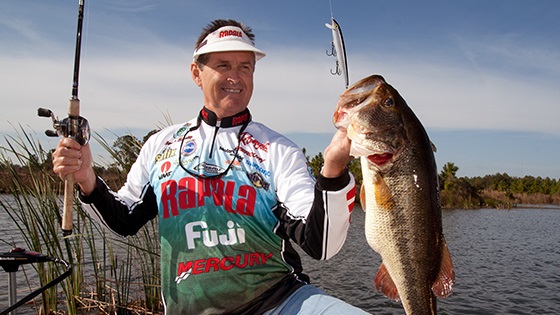 Lure fads come and go, but fish still fall for the Original Floating Rapala. And they always will. “To me, it’s the purest form of an artificial lure that there is,” says Bassmaster Elite Series pro Bernie Schultz. “It’s got that classic baitfish profile with a built-in, erratic action that will look like a struggling baitfish and signal vulnerability. Those are key components when you’re trying to fool fish — whether they’re in a feeding mood or not.
Lure fads come and go, but fish still fall for the Original Floating Rapala. And they always will. “To me, it’s the purest form of an artificial lure that there is,” says Bassmaster Elite Series pro Bernie Schultz. “It’s got that classic baitfish profile with a built-in, erratic action that will look like a struggling baitfish and signal vulnerability. Those are key components when you’re trying to fool fish — whether they’re in a feeding mood or not.
Bass and other gamefish have fallen for Original Floating Rapalas since they burst onto the American fishing scene in the early 1960s through an article in the famous Marilyn Monroe issue of Life magazine. And the lures that launched the Rapala revolution remain productive, especially in clear water in spring and early summer. Remembering that gives Schultz an advantage over anglers, he says.
“This time of year, I’ve always got one tied on any time I’m fishing clear water,” he says. “I’m throwing something that most anglers aren’t throwing. So by the time six or eight anglers go down the same shoreline, those fish have repeatedly seen the same lures. I can’t tell you how many times I’ve gone behind those guys with an Original Floater and cleaned up.”

Whether twitched on top as a surface bait, retrieved as a shallow runner, weighted with a split shot for medium depth or bottom-walked off a three-way swivel or bottom bouncer, the Original Floating Rapala’s wounded-minnow action continues to be irresistible to fish of all species, including bass, walleye, pike and crappie.
In the spring, Schultz often targets bass spawning beds with an Original Floater. “Bass are very territorial and they’re very protective against panfish — trying to keep them from interfering with their spawning activity,” he explains. Cast the Floater beyond the bed and work it slowly through the area, imparting subtle action.
“Throw it out there and wait for the impact rings to dissipate,” Schultz instructs. “Then twitch it a couple times and then let it float back up and sit. The idea is to get movement without the bait moving forward, and keep it in the strike zone. That’s the key — 90 percent of the strikes happen when the bait’s sitting almost still on the surface, or when you first move it after it’s been paused.”
Outside of the spawning season, target shallow cover near current, either wind-induced or natural. Shallow rock, wood and vegetation will all hold fish looking to ambush prey.
“If I’m working specific targets — like stumps or beds, lily pad stems or cypress knees or something — I’m going to reel in once I’m past the target and throw it again, either at that same target, or to another one,” Schultz says. “But if I can’t really see the cover and the fish could be anywhere — in submerged grass, scattered pads, eel grass — I’ll work it back closer to the boat before I reel in and make another cast.”
All Original Floating Rapalas are constructed of balsa wood and hand-tuned and tank-tested to ensure their world-renowned action, straight from the box. They feature premium black-nickel VMC treble hooks.
For the best results, fish an Original Floating Rapala on a 6-foot, 10-inch to 7-foot, 2-inch medium to medium-light action spinning rod spooled with 8- to 12-pound-test monofilament line. Schultz favors Sufix Superior mono. Fluorocarbon line is not advised for most floating lures, because it sinks. And if you start downsizing lures, “you gotta lighten up on the line to make the lure act right,” Schultz advises. “You can restrict the mobility the lure has using heavier line with smaller baits.”
